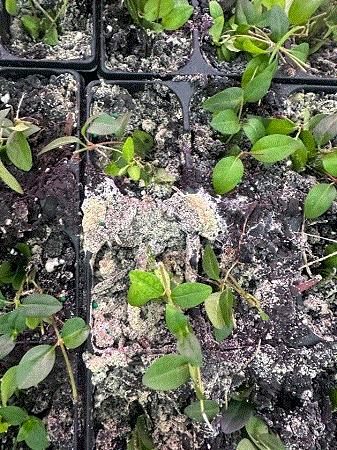What’s Happening Here?
It’s been a while since I’ve challenged your diagnostic skills in the game I call “What’s Happening Here?” In case you’re new to the newsletter (welcome aboard!), from time to time I open the newsletter with a challenge by showing you an image and possibly sharing a clue or two and then I ask you to identify the issue in the photo by the end of the newsletter. It’s honestly a fan favorite and who doesn’t like to reinforce their diagnostic skills or learn a few new things (that’s probably why you’re here to begin with).
Alright, let’s get things going. Take a look at this image below.
When diagnosing problems in the greenhouse, I usually start with a close-up of the issue and then step back to get a bigger picture view of the area. If this were in real time, a grower would likely first see this large block of plants and then investigate closer to see what’s going on.
As you can see, the surface of the growing mix appears unusually white from afar. Kneeling down and taking a closer look, this is what you’ll see.
This is something many of you may have seen before; I definitely have. I think these images are enough for you to narrow down your diagnostic options. Having said that, I will give one and only one clue: this problem literally appears overnight.
Do you know “What’s happening here?”

Mastering Photoperiod
This is hot off the press. I just saw Bill Calkins’ lastest Tech On Demand newsletter and thought he shared some great content on photoperiod and thought I’d pass it along. Photoperiod is important for growers aiming to sell color in the spring when the day lengths are naturally short as many perennials require long day lengths to induce flowering. Here’s the content Bill shared with his subscribers.
We have a four-part Tech On Demand MINISERIES covering the topic (photoperiod). In the series, Dr. Will Healy takes the current research related to photoperiod response of greenhouse crops and breaks it down into understandable information that will help you avoid flowering and growth issues and nail your crop timing.
Get ready for a quick trip through different flowering classifications—Day Neutral, Long Day and Short Day—with time spent on major crops that fall into each group.
For the FIRST VIDEO, Will explains some terminology and background knowledge in flowering classifications that will help you and your team make production decisions using photoperiod response.
Looking specifically at day-neutral crops in PART TWO, he details a couple of the key ones—geraniums and impatiens—as well as other common annuals and perennials.
In the THIRD VIDEO, Will focuses on facultative long-day plants, starting with petunias, before breaking down the photoperiod response of calibrachoas, pansies, violas, snapdragons and more.
Wrapping up the photoperiod miniseries with VIDEO FOUR, Will turns his attention to short-day plants—specifically garden mums, poinsettias and zinnias.
Thank you Bill for always putting together a top-notch newsletter. Click
HERE to see the latest edition of
Tech On Demand. If you like what you see,
click here to Subscribe.

Easy Perennial Production
In case you missed it the other day, you can catch the recording of the GrowerTalks webinar, “Your Guide to Easy Perennial Production.”
Jim Kennedy, Ball Seed Sales Director and Darren Barshaw, Darwin Perennials Product Representative, joined forces to share lots of tips on putting together and managing a perennial program. They discussed a range of topics including scheduling, propagation, crop culture and other relevant tips for producing perennials.
Darren reminded me of the “
First Year Flowering Tool” Darwin Perennials developed a couple years ago. The easy-to-use tool can be used on PCs or mobile devices and contains tons of cultural information (from propagation to finishing containers) and provides the information you need to schedule a specific perennial for any desired sales date. Simply search the variety and enter the desired ship date and like magic, everything you need pops up on the screen.
Here’s the links you need for the scheduling tool and the FREE Webinar:

Upcoming Perennial Webinar
GrowerTalks will be hosting another excellent perennial webinar next month.
Top New Perennials at 2024 Retail &
a Preview of 2025’s Must Watch Perennials
|

Laura Robles
|
Date: Thursday, March 7, 2024
Time: 1:00 PM EST/12:00 PM CST
|
Join Walters Gardens Regional Product Manager Laura Robles on March 7 as she reviews the top new Proven Winners perennials available for 2024. Not only will she be sharing what’s hot now, Laura will also be giving us a preview of the top upcoming varieties for 2025. This will be an excellent opportunity to see some of the hottest new perennials on the planet. See you there.
The Answer Is ...

I showed the image above at the top of the newsletter and asked if you could diagnose the issue or the cause of the white appearance on the surface of the growing mix. The only clue I shared is this problem appears overnight. Perhaps I can share two more clues at this time. First, the plant does not influence the development or severity of the white appearance. Secondly, I’ve referred to this as a problem or issue; however, as you’ll soon learn, this is really not a problem.
Have you narrowed down your choices? If you answered saprophytic fungi or mold, you correctly solved the first challenge of the year. Congrats!
Why It's Not a Problem
It may seem surprising how something like saprophytic mold that not only appears overnight but can completely cover the surface of the growing mix is only a temporary nuisance rather than a problem growers need to be concerned with.
That’s right, saprophytic fungi are not pathogenic and will not harm or attack plants. They grow and work on breaking down organic matter. The white appearance on the surface of the growing mix is the fruiting bodies of the fungi.
The white appearance typically only lasts a few days and then will begin to dry out, darken in color and overtime will become barely noticeable. The above images were taken just four days after the initial images used for this challenge and no control measures were implemented.
With their short life cycles, it’s not usually necessary to treat or control saprophytic fungi. Even though they’re an eyesore when they do occur, I usually do not apply anything to control them. If you don't want to wait it out and feel it’s necessary to control them, many fungicides such as iprodione or thiophanate methyl can be applied to the surface of the growing mix to help them disappear more quickly.




Thanks for reading this edition of Perennial Pulse. My email is paul@opelgrowers.com if you have any comments, article suggestions or if you'd just like to say hello.
Best regards,

Paul Pilon
Editor-at-Large—Perennial Pulse
Director of Growing—Opel Growers
This email was received by you and 34,710 other fine subscribers!
If you're interested in advertising in Perennial Pulse, contact Kim Brown ASAP and she'll hook you up.